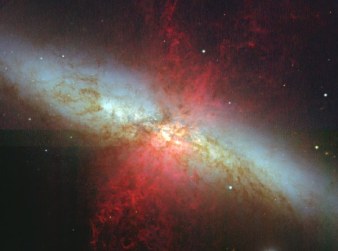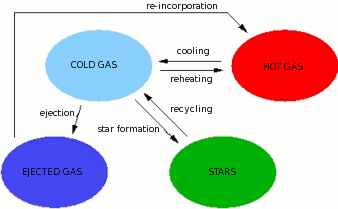|
|
 |
Clusters of galaxies contain a hot gas with a temperature of millions
of degrees that is so hot that it produces X-rays. This gas has a
total mass that is usually much larger than the total mass in stars
and is commonly referred to as `intra-cluster medium' or
`intra-cluster gas'. X-ray observations suggest that this gas also
contains a significant amount of heavy elements (like iron, oxigen
etc.; note that all the elements heavier than helium are usually
called `metals' in astronomy). Since the only sources of such heavy
elements are fusion reactions in the centres of stars, their detection
suggests that a substantial fraction of this gas must have been
ejected from the stars in galaxies into the intra-cluster medium. A
few unresolved questions are: how were these metals transported from
the galaxies into the intra-cluster gas? When did this chemical
pollution occur? And which galaxies are mainly responsible for the
large amount of metals in the intra-cluster gas? Astronomers believe
that an effective way to transport metals from the intergalactic
medium into the intracluster gas is by `galactic winds'. These are
generated by supernovae heating of the intergalactic gas to such high
temperatures that the thermal energy of the gas becomes larger than
the binding energy of the galaxy so that the heated gas is allowed to
`escape'. Figure 1 shows a beautiful example of such a wind.
Researchers at Max-Planck-Institute for Astrophysics have investigated
these questions combining high resolution numerical simulations and
`semi-analytic' techniques. The basic assumption of these models is
that galaxies form at the centre of dark matter haloes, whose
evolution is followed using the results of high resolution numerical
simulations. The evolution of the baryons inside these haloes is then
modelled using simplified prescriptions that are physically motivated
and supported by observational results. This kind of modelling is
quite complex, since one has to follow many mixing and exchange
processes between different phases. Figure 2 shows a schematic
representation of the physical processes that are included in our
model.
Model results can be compared to specific observational data in order
to fix the free parameters of the models. The models can then be used
to make predictions that can be tested by completely different
observational data. With this kind of tooll it is for example possible
to predict the amount of metals in different phases as a function of
redshift. This is shown, for a particular model in Figure 3. Using
this kind of approach, researchers at Max-Planck-Institute for
Astrophysics have shown that metals have been ejected into the
intra-cluster medium at high redshifts and that `massive' galaxies
represent important contributors to the chemical enrichment of the
intra-cluster medium. The results obtained suggest that gas and its
associated metals must be ejected very efficiently from galaxies and
their associated dark matter haloes. Once the material leaves the
halo, it must remain in the diffuse intergalactic medium for a time
that is comparable to the age of the Universe.
Gabriella De Lucia
For further information:
Gabriella De Lucia, Guinevere Kauffmann and Simon D. M. White:
Chemical enrichment of the intra-cluster and intergalactic medium in a hierarchical galaxy
formation model, 2004, MNRAS, vol. 349, p. 1101
|




